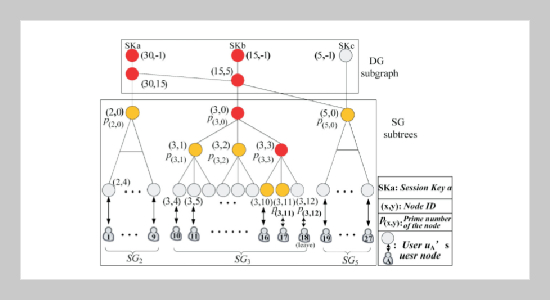REFERENCES
- [1] Rafaeli, S. and Hutchison, D., “A Survey of Key Management for Secure Group Communication,” ACM Computing Surveys, Vol. 3, No. 35, pp. 309�329 (2003). doi: 10.1145/937503.937506
- [2] Trappe, W., Song, J. H., Poovendran, R. and Liu, J. K. R., “Key Distribution for Secure Multimedia Multicasts via Data Embedding,” 2001 IEEE International Conference on Acoustics, Speech, and Signal Processing Proceedings (ICASSP’ 01), Vol. 3, pp. 1449�1452 (2001). doi: 10.1109/ICASSP.2001.941203
- [3] Wong, C. K., Gouda, M. G. and Lam, S. S., “Secure Group Communications Using Key Graphs,” IEEE/ ACM Transactions on Networking, Vol. 8, No. 1, pp. 16�30 (2000). doi: 10.1109/90.836475
- [4] Song, R. G., Korba, L. W. and Yee, G. O. M., “A Scalable Group Key Management Protocol,” Journal of IEEE Communications Letters, Vol. 12, No. 7, pp. 541�543 (2008). doi: 10.1109/LCOMM.2008.080430
- [5] Chiou, G. H. and Chen, W. T., “Secure Broadcasting Using the Secure Lock,” IEEE Transactions on Software engineering, Vol. 15, No. 8, pp. 929�934 (1989). doi: 10.1109/32.31350
- [6] Xu, J. Z., Dong, Y. X. and Liang, K. H., “Efficient Key Management Scheme for Dynamic Multicast Groups,” Application Research of Computers, Vol. 27, No. 3, pp. 1061�1063 (2010).
- [7] Balenson, D. M., McGrew, D. A. and Sherman, A. T., “Key Management for Large Dynamic Groups: One Way Function Trees and Amortized Initialization,” Advanced Security Research Journal, NAI Labs, Vol. 1, No. 1, pp. 27�46 (1998).
- [8] Sun, Y. L. and Liu, J. K. R., “Scalable Hierarchical Access Control in Secure Group Communications,” Proceedings of INFOCOM 2004, Twenty-Third Annual Joint Conference of the IEEE Computer and Communications Societies, Vol. 2, pp. 1296�1306 (2004). doi: 10.1109/INFCOM.2004.1357015
- [9] Wang, G. J., Ouyang, J., Chen, H. H. and Guo, M. Y., “Efficient Group Key Management for Multi-Privileged Groups,” Computer Communications, Elsevier, Vol. 30, No. 11�12, pp. 2497�2509 (2007). doi: 10.1016/j.comcom.2007.04.019
- [10] Muthulakshmi, A., Anitha, R. and Sumathi, M., “NonSplit Balancing Higher Order Tree for Multi-Privileged Groups,” WSEAS Transactions on Communications, Vol. 10, No. 10, pp. 308�321 (2011).
- [11] Gu, X. Z., Zhao, Y. J. and Yang, J. Z., “Reducing Rekeying Time Using an Integrated Group Key Agreement Scheme,” Journal of Communications and Networks, Vol. 14, No. 4 (2012). doi: 10.1109/JCN.2012. 6292248
- [12] Muthulakshmi, A. and Anitha, R “Balanced Key Tree Management for Multi-Privileged Groups Using (N, T) Policy,” Security and Communication Networks, Vol. 5, No. 5, pp. 545�555 (2012). doi: 10.1002/ sec.351
- [13] Ma, D., Deng, R. H., Wu, Y. D. and Li, T. Y., “Dynamic Access Control for Multi-Privileged Group Communications,” International Conference on Information and Communications Security (ICICS 2004), Lecture Notes in Computer Science (LNCS) 3269, Springer-Verlag, pp. 508�519 (2004). doi: 10.1007/ 978-3-540-30191-2_39
- [14] Cruz, J. R. P., Hernandez, S. E. P., Gomez, G. R., Drira, K. and Diaz, M., “Multi-Session Key Management Scheme for Multimedia Group Communications,” Journal of Internet Technology, Vol. 1, No. 1, pp. 67� 78 (2012).
- [15] Hassen, H. R., Bettahar, H., Bouadbdallah, A. and Challal, Y., “An Efficient Key Management Scheme for Content Access Control for Linear Hierarchies,” Computer Networks, Vol. 56, No. 8, pp. 2107�2118 (2012). doi: 10.1016/j.comnet.2012.02.006
















